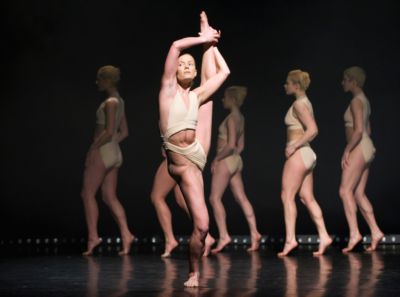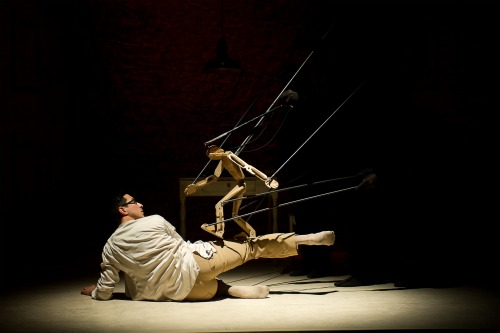I like New York City in summer. Outdoor performances, picnics in the park, sidewalk cafes, late sunset strolls beside the Hudson or on the High Line. On the other hand, if you can swing it, not much beats lying on the lawn at Tanglewood and listening to music; it seems to be coming from the galaxy above. Another venerable Berkshire institution, Jacob’s Pillow, draws dance aficionados and culture seekers. There’s something satisfyingly summery about dining (or picnicking) on the grounds and taking in a free performance on an outdoor stage framed by trees, before entering one of the two theaters housing what you bought tickets for.
From June 29 to July 3, Carte Blanche, the Norwegian National Company of Contemporary Dance made its U.S. debut in the theater named after the Pillow’s founder, Ted Shawn. From July 6 through 10, the smaller Doris Duke Studio Theater housed Kidd Pivot Frankfurt RM, a Canadian company currently in the middle of a two-year residency in Frankfurt. Both have what you might call an international flavor.
Carte Blanche commissioned Killer Pig in 2009 from Sharon Eyal, currently the resident choreographer for Israel’s Batsheva Dance Company. Eyal’s choreography takes no prisoners. The six women in Killer Pig have their hair plastered with off-white stuff that matches their attire—halter tops attached to skimpy, diaper-like bottoms. They look like hostile, bendable-plastic dolls. Clustered, they twitch and wrench their bodies around, syncopating the repetitive, drums-up-front hammer Ori Lichtik’s score. These women are out to seduce us with their strength and decisiveness. They may mince around like high-heeled, beauty contest hopefuls, but when, say, the terrific Guro Rimeslåtten comes to the front of the stage and thrusts one shoulder and then another at the audience, you’re less likely to be turned on than to hope you’d never meet her in a dark alley.
They’re marvels, these women, and the fact that Eyal, bit by bit, presents them as individuals mitigates their relentless displays of aggressive sensuality and their lacquered appearance. The smallest of them, Jennifer Dubreuil Houthemann, is the first to show us litheness; she can grasp one leg and yank it up to point at the ceiling or sink to the floor in a split, staring at us. Camilla Spidsøe Cohen is the dancer you notice for the cabrioles, pas de chats, and other balleticisms that Eyal sprinkles into the muscle work. Caroline Eckly’s dancing has more nuanced contortions; you wonder what she’s doing in this pack of athletes running amok.
Eyal’s Love, the other work on the program, is less finely constructed than Killer Pig, and it’s a letdown to see the jerking, torqueing movements that seemed intriguing and unusual in the former become the standard language of the latter too. Love? Really? Although six lusty male dancers join the women for this 2003 piece (made for Batsheva), it seems more about the impossibility of finding happiness with another when you’re uncomfortable in your own skin.
Sometimes members of this championship society fall into unison; sometimes everyone’s engaged in a different activity. This time, when Houthemann hoists her leg to high noon, she follows up with a backbend and a flip. Topsy-turvy with passion? I don’t think so. Intermittently dancers pair up, but not for any enduring relationships. They show their power; sinking into a deep lunge, they could be crushing some invisible weakling beneath their thighs. Only at the end when Lisa Germano’s little-girl voice emerges from the accompanying pop music collage, singing her “From a Shell,” do they become less frantically athletic. “There is love. . .it’s a buzz, it’s a buzz, it’s a buzz. . . .” Men and women exit on opposite sides of the stage, while the song keeps going. Who are these people, anyway, and what do they want? Eyal doesn’t tell us.
The following week at Jacob’s Pillow, the smaller barn of the Duke, hosts Crystal Pite’s Dark Matters, choreographed for her company, Kidd Pivot Frankfurt RM. The initial image: a man is bending over a table in a folding-screen stage set by Jay Gower Taylor. Imagine a cramped room with brown wallpaper. The man (the marvelous Peter Chu) is cutting and joining together shapes we can’t quite make out in the glow of the lamp that hangs over the table. We hear the amplified sounds of scissors on paper, before Owen Belton’s effective music slides in to add to the atmosphere. Suddenly the mysterious craftsman is kneeling to test a small pair of flattish wooden (or heavy cardboard) legs. Two blackouts later, he’s confronting a faceless puppet something over two feet tall, manipulated by five black-clad figures who hold long wands attached to his head and limbs.
Pite’s puppetry image is a dark one—especially compared to that projected by the tiny creature that had appeared in the same theater the previous week. The four dancers in a revival of Jane Comfort’s deeply moving Underground River (1998) assembled Basil Twist’s puppet out of white strips of cloth, while walking in circles singing. That little dancing figure (and its four puppeteers) represented an unseen child who, worried voices let us know, lay in a coma. What we saw was her perky, playful self, and the soar of her spirit.
The homunculus that Robert Lewis designed for Dark Matters is no mischievous, filial Pinocchio. He’s a child from hell—now charming, now fawning, now destructive. Trying to get attention, he climbs on the worktable and scatters the scraps that litter it; he hurls to the floor the little red trousers that his creator makes for him; he tries to pull down the papery walls. We don’t need the occasional excerpts from one of Pite’s inspirations, Voltaire’s despairing, anti-religious Poem on the Lisbon Disaster, to be able to absorb from Dark Matters doubts about the infallibility and benevolence of gods and the need for hope (Christopher Gaze’s mellifluous British voice seems to come from the radio on the puppet-maker’s table).
Eventually, the diabolical little fellow attacks Chu, who, in desperation, responds with a hastily-cut-out cardboard axe (their battle is a triumph for the agile handlers). The puppet, ironically, goes for something real (and sharper): the scissors that formed him. In the end, both puppet and master lie limply on the floor, their limbs identically arranged, while the puppeteers clean up and fight rowdily among themselves like comedians in a Mack Sennett movie. Then: the earthquake. The walls crash down, and the last puppeteer standing pulls Chu from the wreckage and walks him off like a big dazed doll.
In the second half of Dark Matters, Chu and five others (Eric Beauchesne, Yannick Matthon, Jiri Pokorný, Cindy Salgado, and Jermaine Maurice Spivey) appear in ordinary clothing (costumes by Linda Chow). As they dance—in twos, threes, fours, etc.), they fleetingly echo the puppet imagery. Because they wear socks, they can slide into formations as fluidly as they can articulate their torsos and limbs (Pite was once a member of William Forsythe’s Ballett Frankfurt and inherited his predilection for silky deconstructions of human movement). Salgado walks up Matthon’s reclining body, just as the puppet walked up Chu’s. And whenever these people meet, they tangle together in complex, shifting organisms. The distinction between who’s being manipulated and who’s manipulating become cloudy; in these slippery clusters, people may roll their necks along others’ outstretched arms or press a hand on someone’s head only to be pushed down themselves as a consequence of the flow of action. Even a lone puppeteer from the first part is no more dominant than anyone else.
Just as this tangling and untangling and glancing off one another begins to feel as if it’s going on too long, Pite pulls out a soul-searing ending. Chu performs a startling solo in which he seems to be manipulating himself. The single puppeteer returns (it is Sandra Marín Garcia) and slowly divests herself of her gloves, hood, black veil, and black velvet suit, Stripped to a flesh-colored bra and trunks—as implicitly naked as the wooden puppet—she lies down. Chu raises her up and gently, sensitively manipulates her. They kiss. Voices soar around them (Eric Whitacre’s beautiful composition Sleep). Suddenly tormented, the man hurls himself around, then collapses. The woman sits down, pulls his limp body across her lap, and mimes carefully stitching up his chest. Is she mending a broken heart, closing an empty bosom, turning him into her puppet? They embrace. Love among the ruins? Love the healer-destroyer? You choose. Then, at the Pillow, you walk out into the night and the reassuring din of crickets.




I love this post on the work of Crystal Pite, which thanks to White Bird Presents I’ve seen here in Portland, Oregon a couple of times, as well as the excellent Mr. Spivey in work by Rumpus Room. And the acuity of your description of the action both in Pite’s work and Sharon Eyl’s absolutely provides the critical response that I want from you and all our colleagues. I hope Pite’s “Dark Matters” comes our way; it’s fine with me if “Killer Pig” does not.
owww, fonderfull.. 🙂